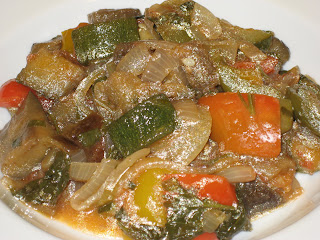 I made this recipe as a vegetarian alternative to the beef bourguignon that I made when some friends came over for dinner a few weeks ago.
I made this recipe as a vegetarian alternative to the beef bourguignon that I made when some friends came over for dinner a few weeks ago. Cute, cartoon rodents notwithstanding, ratatouille, or ratatouille niçoise, as it is more properly called, is a traditional Provençal dish that, like beef bourguignon and coq au vin, has made the transition from peasant comfort food to haute cuisine.
Cute, cartoon rodents notwithstanding, ratatouille, or ratatouille niçoise, as it is more properly called, is a traditional Provençal dish that, like beef bourguignon and coq au vin, has made the transition from peasant comfort food to haute cuisine. There are numerous variations of the recipe for ratatouille. Some recipes omit the eggplant. Some recipes, like Julia Child's, calls for layering and and baking the vegetables. Other recipes call for cooking the vegetables all together. The Book's recipe is pretty fussy in that it calls for cooking each of the vegetable elements separately.
First, I peeled four large tomatoes. I actually don't mind peeling tomatoes as long as I'm not too pressed for time. I think it's pretty cool that you can plop a tomato into boiling water for a minute or two, then plunge it into ice water, and just slip the skins right off. Then I coarsley chopped the tomatoes and simmered them in a pot with some garlic, parsley, basil, and olive oil to make a basic tomato sauce.
While the sauce was simmering, I cut a large eggplant into one-inch cubes. The Book says to toss the cubes with salt and let them sit in a colander for 30 minutes. I don't know if this step is really necessary. I didn't have any room in my sink to set down the colander, so I put it on a tray on my kitchen table. When the half-hour had passed, only a very small amount of liquid had drained from the eggplant. So, I didn't really see the benefit to this step.
Here's where the recipe gets really fussy, and for no clear reason. First The Book says to cook the onions in three tablespoons of olive oil for ten minutes, remove from the pan and set aside. This step is repeated with the peppers, zucchini, and eggplant. Cook with three tablespoons of olive oil for about ten minutes. I'm not quite sure why the vegetables need to be cooked separatly, other than the fact that there are a whole lot of them, and it would be difficult to cook such a big quantity of vegetables all at once. I can't see any other reason for doing it that way, especially since once they've all been given their 10 minutes in the saute pan, all of the vegetables are combined with the tomato sauce and stewed together for an hour. And it's not just me, Teena thought that this recipe was curiously fussy, too.
Even if it was fussy, there is no denying that this dish was delicious. It was hearty, comforting and flavorful. The tomato, garlic and basil in the sauce was a great base for the slowly stewed vegetables. The Book says that it can be served warm or at room temperature. I actually preferred it hot, but to each his own.The recipe calls for a lot of olive oil, and while I didn't find the dish to be overly oily, the amount of oil could have been cut significantly without harming the dish too much. The Book says that this recipe serves 8 to 10. That must mean 8 to 10 very hungry people. This recipe filled my big stock pot, and we enjoyed this for lunch for the entire week after I made it.
Date Cooked: November 16, 2008Degree of Difficulty: Not hard, but a lot of steps
Rating: A-



2 comments:
I'm definitely trying this one, but I guarantee I will not be sauteeing each vegetable separately!
I might even sub canned tomatoes for the fresh, because they're out of season and I'm just that lazy.
:)
You know, this would be a good recipe to freeze for future dinners. You could serve it on noodles.
Ahem, who chopped all those veggies again? I think it was your sous chef. Your very pregnant sous chef . . .
Post a Comment